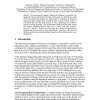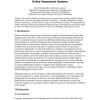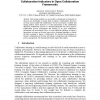EDM
2009
13 years 9 months ago
2009
In this paper, we present a study of a large corpus of student logic exercises in which we explore the relationship between two distinct measures of difficulty: the proportion of s...
EDM
2009
13 years 9 months ago
2009
The monitoring and support of university freshmen is considered very important at many educational institutions. In this paper we describe the results of the educational data minin...
EDM
2009
13 years 9 months ago
2009
This paper describes a novel method to create a quantitative model of an educational content domain of related practice item-types using learning curves. By using a pairwise test t...
EDM
2009
13 years 9 months ago
2009
This paper presents a model which can automatically detect a variety of student speech acts as students collaborate within a computer supported collaborative learning environment. ...
EDM
2009
13 years 9 months ago
2009
Student modeling is a widely used approach to make inference about a student's attributes like knowledge, learning, etc. If we wish to use these models to analyze and better u...
EDM
2009
13 years 9 months ago
2009
This paper presents an agent-based educational environment to teach argument analysis (ALES). The idea is based on the Argumentation Interchange Format Ontology (AIF) using "W...
EDM
2009
13 years 9 months ago
2009
Traditional data mining techniques have been extensively applied to find interesting patterns, build descriptive and predictive models from large volumes of data accumulated throug...
EDM
2009
13 years 9 months ago
2009
Abstract. Most of the emphasis on mining online assessment logs has been to identify contentspecific errors. However, the pattern of general "consistency" is domain indep...
EDM
2009
13 years 9 months ago
2009
EDM
2009
13 years 9 months ago
2009
Data mining methods are successful in educational environments to discover new knowledge or learner skills or features. Unfortunately, they have not been used in depth with collabo...



